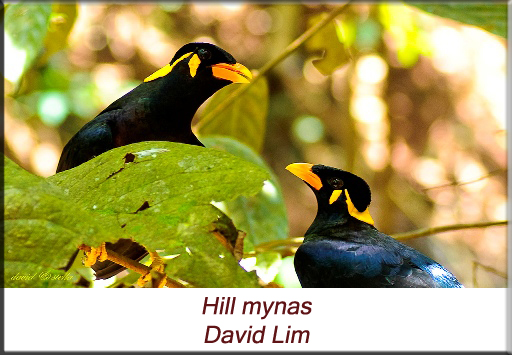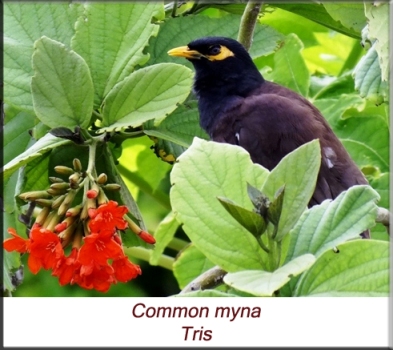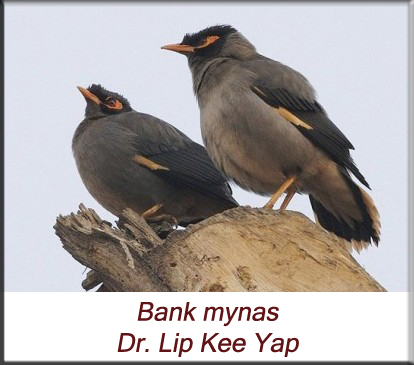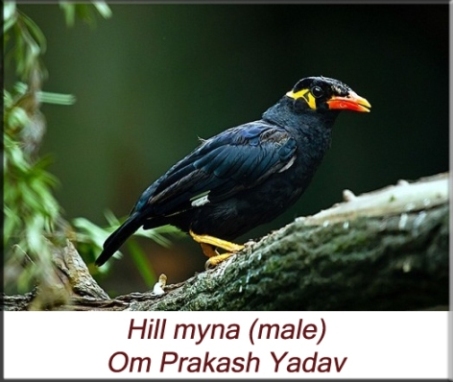Protocols for the hand-raising and rehabilitation of mynas
Corina Gardner

Introduction
Mynas are average sized (about 22-28 cms) passerine birds which belong to the family of starlings, Sturnidea. The term ‘myna’ is commonly used to refer to starlings in India. Mynas are commonly distributed throughout Southern and Eastern Asia. These birds have duller plumage and are more terrestrial compared to other members of the starling family.
Common myna, Acridotheres tristis
The common myna is widely distributed throughout India and Asia and has also been introduced to many parts of the world. The species lives in woodlands and near human habitations. They have brown plumage, a black head, throat and breast, while the bill and legs are yellow. They also have a distinctive yellow patch behind the eyes. They are omnivorous birds and will scavenge for just about anything including discarded scraps, insects, seeds, grain and fruit. They roost in large trees and build their nests in walls and rooftops of buildings.

Jungle myna, Acridotheres fuscus
Jungle mynas are found in and around the Indian subcontinent. They have brownish grey plumage, a tuft of feathers on their heads, white patches on their primaries and a white tipped tail. They typically live in forests, tea plantations and near paddy fields. They are omnivorous birds and their diet often consists of insects, fruit, seeds and even nectar from flowers.
Bank myna, Acridotheres ginginianus
This species of myna is found primarily in the Indian subcontinent. The species resembles both the common and jungle myna but their plumage is slaty grey with a black head and bare brick red patches behind the eyes.
The Bank myna obtains its name due to its habit of building its nest on the earthen banks of rivers and streams. These birds hollow out holes or cavities in the earth to build their nests. Although, this is their favored nesting environment, they also readily build their nests in brick walls and roost in trees. Their preferred habitat is near water bodies, cultivated farmland, open country, as well as near human habitations. They are found in villages, towns, markets and railway stations all over the country where they scavenge for scraps. Bank mynas are very often seen near grazing cattle in fields picking up insects that have been disturbed by the animals. Their diet also includes fruit and grain.

Common hill myna, Gracula religiosa
Hill mynas are well known for their remarkable ability to imitate human speech and the vast repertoire of sounds they produce. The species occupies a huge range stretching from Burma, Garo Hills (Meghalaya), Assam, Nepal, Orissa, South India, Sri Lanka, Andaman and Nicobar Islands, to Northern Thailand and South China. Hill mynas have glossy black feathers tinted with purple. All have similar bright yellow wattles but the wattle pattern varies according to the species and the bright orange beak fades to yellow at the tip. There's a band of white across each wing while the legs and feet are yellow. The average lifespan of a myna ranges from 12-25years.

Brahminy starling, Sturnia pagodarum
Brahminy starlings are resident to Nepal and India. They have pale reddish-fawn plumage with a grey back, a black crest and a yellow bill with a bluish base. The crests of the males are more prominent than those of the females. Their habitat ranges from jungles, marshy lands and fields, to human habitations. Like most species of starling, these birds too are omnivorous, feeding on insects, fruits and seeds. These starlings are very often seen in fields near grazing cattle. They live in pairs or small flocks, roosting in large trees and building their nests in tree cavities and holes in walls of buildings. These passerines have a delightful musical chattering call.
Characteristics of mynas
Mynas are very sociable, inquisitive, lively and intelligent birds. Hill mynas in particular make wonderful pets, and are hugely popular in the West. Prized for their exceptional vocal skills, the Hill myna has been described by many as the best talking bird in the world. These birds have an immense repertoire of sounds and are extraordinary mimics, though some species are more loquacious than others. These truly incredible mimics make it difficult to differentiate between a human voice and a hill myna’s as they speak and whistle exactly like people.
Hill mynas prefer forest edges and cultivated land in areas of high rainfall. Because of deforestation, the number of Hill mynas is considerably less than it once was, and they have been forced to live at lower elevations. In their natural habitat, they live in pairs or small flocks although they prefer to roost in large numbers at night. As with most species of birds, mynas become especially noisy just before sunrise and sunset. Their sounds include shrill whistling and screeching noises. Mynas nest in tree hollows or cavities high above the ground, where they usually pad their nest with grass, leaves, twigs and feathers.
Hill mynas feed on ripened fruit; therefore, they prefer areas where there is an abundance of fruit. They eat berries and seeds from a wide variety of trees and shrubs, and nectar from several kinds of flowers. Occasionally, they eat insects from the foliage of trees and their diet includes termites as well.
Guidelines for hand-rearing mynas
The breeding season for mynas is usually from April-September in India. A mynas clutch usu



